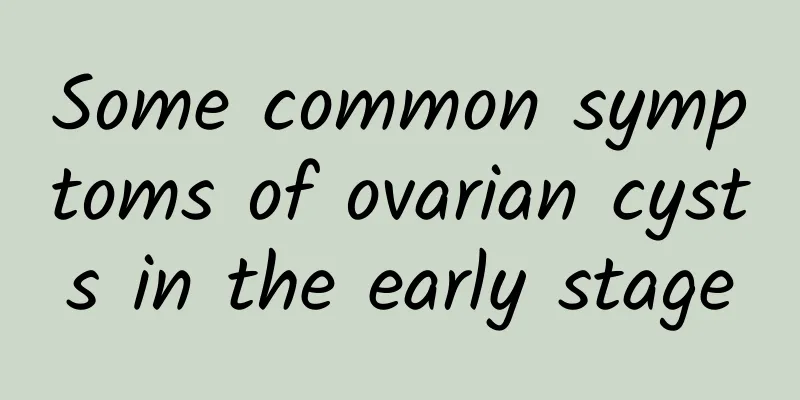Why does uterine fibroids grow during cesarean section? Is uterine fibroids more likely to develop during cesarean section?

|
Why does a cesarean section cause uterine fibroids? Is a cesarean section more likely to cause uterine fibroids? Caesarean section is an emergency way of childbirth, but in recent years, some studies have found a certain correlation between caesarean section and uterine fibroids. So why does uterine fibroids grow after caesarean section? Does caesarean section easily lead to the occurrence of uterine fibroids? Let's explore this question together. text: 1. Hormone changes After a cesarean section, a series of hormonal changes occur in the uterine lining in order to restore the normal function of the uterus. However, this hormonal change can sometimes lead to the growth of uterine fibroids. Due to the surgical interference of the cesarean section, the metabolism and hormone balance of the uterus may be altered, leading to the abnormal proliferation of fibroid cells. 2. Post-traumatic repair Caesarean section is a surgery that directly enters the uterus after cutting open the abdominal wall. This process is a major trauma to the mother. The repair process after the trauma may stimulate and promote the growth of fibroids. In addition, the uterine wall may be cut during the cesarean section, causing damage, which also provides a basis for the development of fibroids. 3. Genetic factors Caesarean section is undoubtedly an intervention method. The environment of the mother's uterus will change, which also provides an environment for the genetic factors of fibroids. Some studies have found that fibroids have a certain degree of genetic tendency. Caesarean section may stimulate or accelerate these existing genetic factors, thus leading to the appearance of fibroids. The above are some reasons why uterine fibroids may develop after a cesarean section. However, not every woman who has a cesarean section will develop fibroids, and the probability of occurrence is low. Cesarean section is a method used to protect the lives of mothers and babies. When faced with serious obstetric problems, cesarean section is still an important choice. Although there is a certain correlation between cesarean section and uterine fibroids, this does not mean that every woman who undergoes a cesarean section will develop uterine fibroids. Therefore, it is very important to choose the best method of delivery based on the specific condition. At the same time, in addition to cesarean section, there are other factors that may cause the occurrence of uterine fibroids, such as genetics, hormone imbalance and lifestyle habits, etc. Therefore, cesarean section is not the only cause of uterine fibroids. Why does uterine fibroids grow after a cesarean section? There may be many unsolved mysteries about this question, which requires further research and observation. The occurrence of uterine fibroids after cesarean section may be related to many reasons such as hormonal changes, post-traumatic repair and genetic factors. However, although there is a certain correlation, not every woman who has a cesarean section will develop uterine fibroids. For women who are about to have a cesarean section or have already had a cesarean section, it is very important to understand the relevant knowledge and communicate with the doctor. |
>>: What department should I go to for B-ultrasound of uterine fibroids?
Recommend
Abnormal vaginal discharge caused by low back pain
Lower back pain accompanied by abnormal vaginal d...
Beware of the three major symptoms of chronic adnexitis
If acute adnexitis is not treated promptly and ef...
What are the types of cervical warts?
Many people know about sexually transmitted disea...
Emergency contraceptive pills may cause ectopic pregnancy
Many women seem to think that taking emergency co...
What are the hazards of cervical erosion in women?
Cervical erosion is a common gynecological diseas...
Can I have an abortion when I am 3 months pregnant?
Artificial abortion is usually called miscarriage...
How to prevent Bartholinitis
Bartholin's gland cyst brings endless trouble...
Can uterine fibroids become cancerous?
Uterine fibroids usually refer to uterine leiomyo...
What are the effective methods to prevent threatened abortion?
What are the effective ways to prevent threatened...
What are the dangers of abortion? Abortion will bring ten major harms to women
If you are unable or unwilling to give birth to a...
Patients with adnexitis need to pay more attention to nursing work in their daily life
Adnexitis is a common disease in life. During the...
Losing weight causes dry skin and constipation. Watering food to remove oil is a problem...
The weather is getting hotter, and everyone wants...
How much does an obstetrics and gynecology check-up cost?
For the sake of women's own health, many doct...
Tomato sobering up? Nutritionist: Fruits and vegetables help restore liver function
Two major beverage manufacturers in Japan collabo...
What are the main things to check before abortion?
Abortion is very common in today's life. Peop...









